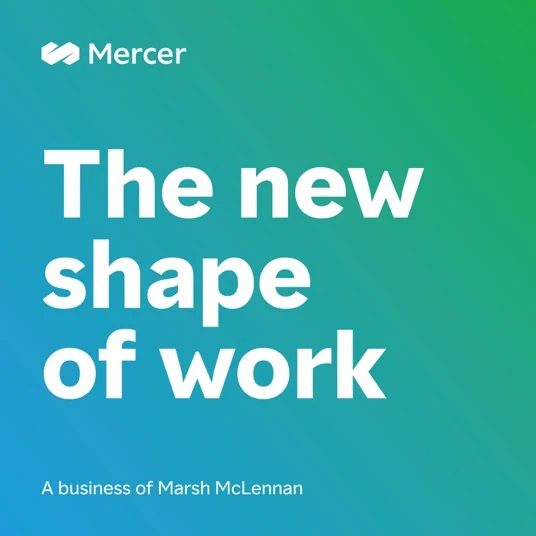NORMAN DREGER: Hello and welcome back to our new shape of work podcast series. My name is Norman Dreger I'm a partner and CEO of Mercer Germany.
Our podcast today deals with addressing racial injustice, and the importance of utilizing an evidence based approach to drive your diversity, equity and inclusion (DE&I) efforts.
The tragic and shocking murder of George Floyd has led to a moment of reckoning, not just in the United States, but also around the globe sparking a worldwide conversation with equity, justice and racism. Email inboxes and corporate blogs have been flooded with heartfelt messages from employees expressing outrage of the inequality, fear, brutality and hate that permeates the lives of both Black people in America, and elsewhere, as well as other marginalized groups around the globe. At the same time, CEOs are reaffirming their commitments to creating workplaces built around the idea of diversity and inclusion. It's a positive sign but will drive a lasting change?
I have with me today Rayna Edwards, principal in Mercer's workforce strategy and analytics practice specializing in diversity, equity and inclusion analytics consulting. Rayna thanks so much for speaking with us today.
RAYNA EDWARD: Thanks for having me, Norman.
NORMAN DREGER: So Rayna in your recent Brink article called “Time to act - Empathy is not enough” you and your co-author Carol Jackson wrote about the say/do gap, that is like the gap between the values companies express publicly and the impact of those values on real behavior and equity. Can you talk a little bit more about the say/do gap and give us some examples so listeners can better understand the implications?
RAYNA EDWARD: Often what we see is there's a significant difference between what companies say publicly, and what's happening in reality when it comes to achieving workplace equity. Our research at Mercer shows that the majority of companies say they're focused on improving diversity and inclusion. But only half of them, even less than half of them, have publicly documented commitments to racial or ethnic equity. We're actually seeing that even fewer organization, only about 23%, review performance ratings by race or ethnicity to insure against adverse impact. We see roughly 38% of companies reviewing engagement survey data by race or ethnicity to understand differences in their employee experience. So with these statistics, you might understand there's a disconnect and it makes it hard for organizations to measure or actually understand how their employees experiences differ based on their race or ethnicity. So their ability to succeed in their organizational goal of creating a culture of inclusion is impacted by their lack of understanding about what's going on in their workforce.
NORMAN DREGER: That makes lots of sense, Rayna. If employers don't know or aren't aware of the issues that their employees are actually facing it makes it hard to address the problem. So on that vein; let's talk a bit more about what we do know about how the employees’ experience of their organization differs, often, based on their race or ethnicity. You reference some eye opening findings from Mercer's Sirota normative database, which represents over 8 million employees globally. What do those results show us?
RAYNA EDWARD: The Mercer Sirota findings show that there is an apparent discrepancy between how Black and white employees experience their organization. Specifically, and for example, we saw that Black employees are 14 percentage points less likely than their white counterparts to agree that their company has created an environment where people of diverse backgrounds can succeed. And just to note, a five percentage point difference is considered statistically notable according to our Mercer Sirota colleagues.
We also saw that Black employees are at a 10-percentage point disadvantage in saying that they work in an environment free from harassment and discrimination, and seven percentage points less likely to say that they can report unethical behavior without fear of retaliation.
We see that these types of disparities also show up in the relationship that employees have with their managers - something that we know to have a profound impact on employee engagement and commitment. In our research, we found that Black employees were less likely to agree that they trust their immediate manager. Our latest results show that 83% of white employees say that they trust their manager compared to 77% of Black employees.
NORMAN DREGER: Thanks for that, Rayna. You know, it's some worrying statistics on trust. Trust is so important to people and having that sense and feeling that they work in an environment that protects them and helps them succeed. And that's so critical for employees and their success.
It sounds, unfortunately, that despite many people's good intentions the actions companies are taking don't seem to be having the desired impact. So what are some actions that employers can take to help them achieve the results that they're looking for, and create a better working environment for all employees.
RAYNA EDWARD: Yeah, that is a good point, Norman. Trust is quite important. And of course, most organizations want the best for their people. They're not setting out to be deceptive, or to be insincere when they express their commitment to creating more equitable and just workplace. But organization do need to be aware that many common practices tend to fall short. So that means that some levers that employers may be pulling currently might not necessarily have the return on investment to make a sustained impact.
So some critical steps that organizations can take that will help them make a real difference are placing accountability for diversity, equity, and inclusion outcomes on senior leaders instead of on human resources colleagues. That's the first note, a lot of times we'll see companies focusing DE&I on HR and really not building it into their business. We see holding senior leaders accountable having measurable impact there.
The second step that we see organizations taking that does make an impact is focusing first on inclusion and then on diversity. So the distinction between the two is that diversity is really counting the numbers and inclusion is creating a culture where people bring their whole selves and feel like they can be who they are in that workplace. If you have a lot of diversity and not a lot of inclusion, what you'll tend to see is a revolving door where your diverse workforce will come in and leave just as quickly because they don't feel that they can be their authentic self at work.
The third step is using unconscious bias training as only a tool in the toolbelt that you might use to address diversity, equity, and inclusion. Not focusing on it as a check the box exercise, and not using it as your only action to achieve that culture of inclusion and to achieve diversity. We often see companies using unconscious bias training as a cover off for their diversity approach and we're advising against that.
Another step that companies can take is partnering with employee or business resource groups for guidance and feedback. But being sure not to put the heavy lifting on them. So we’re talking about underrepresented employees who are volunteering to take roles of leadership within organizations in a business resource group. We want to make sure that we leverage the knowledge and expertise that they will have given their unique experiences, but not make it acceptable for them to be the ones driving strategy or driving action for your organization.
And finally, measuring and monitoring outcomes is critical. Just as you would measure and monitor outcome for a business priority, you want to measure and monitor outcome for your diversity, equity and inclusion strategy. Holding yourself accountable will require transparency in the journey that you're taking. Having numbers that you can tie to the strategy that you're building will be critical to make movement in that space.
NORMAN DREGER: Well, thanks Rayna. You know these are really great actions that an employer can take to get started to create a more diverse, equitable and inclusive working environment. But perhaps if we take things a step further right moving beyond tactical actions to thinking more strategically about hardwiring diversity, equity and inclusion into the culture and structure of the organization itself. Right. And help companies achieve this. The first strategy practice you identify so simple and it's so obvious, yet if often gets overlooked - that practice is quite simply just listening. Can you talk a little more about that?
RAYNA EDWARD: Of course, listening really is the starting point, asking what can be difficult and potentially uncomfortable questions of ourselves and just listening and sitting with that information. Both to the data and listening to the experiences of underrepresented employees. It really means being open to learning a better way. And being open to acknowledge past practices that might not have been the best approach.
A big part of this obviously is talking to your employees. So for many, these are really trying times. And if you haven't already been asking your employees about their personal, professional and societal concerns, you could be missing out on critical information. So during times like these, it's essential to give your employees an opportunity to voice their questions, share their concerns, and identify emerging issues.
There are several ways to measure employee experience. Some are surveys, pulse surveys and employee engagement surveys, you could have focus groups both virtually and in-person. There are advanced analytic techniques like social network analyses. All of these tools help reveal critical information about your employees experience day to day.
Survey results are good place to start identifying whether there are any attitudinal gaps, particularly on items related to basic needs and fair treatment. Looking at those results by race, gender, sexual orientation, and the intersection of different lenses of diversity can give you insights that you would have otherwise not known. Are we seeing written comments that reveal concerns about racism, about sexism, or discrimination in the workplace? These surveys really do allow you to get a pointed insight into an employee's opinions, experiences, and how they're viewing your organization at a certain point in time.
NORMAN DREGER: This focus on people data really makes for a nice segue to the next strategic practices you identify in the report. Practices of representation, transparency and trust to drive workforce representation and to ensure equality of opportunity, experience, and pay. You make the suggestion that organizations really need to take a hard look at their quantitative data and publicly share their progress on DE&I goals. Can you tell us more about this? It sounds fascinating.
RAYNA EDWARD: And this is really the bread and butter of my task so I'm excited to talk about the data.
What we see generally and in Mercer's recent research is that people of color, and specifically Black and Latino employees, are underrepresented it all career levels in the US workforce. The disparity gets even more stark as you move up the career hierarchy and to the executive ranks, you see a substantial underrepresentation of Black and Hispanic or Latino employees. For example, while Black adults represent approximately 13% of the US population. They represent only 2% of US executives according to our When Women Thrive data from 2020.
So a lot of companies think that focusing on talent acquisition and hiring more diverse talent will fix this issue. And although hiring and bringing in diverse talent is a critical piece of the puzzle, our research and extensive work with clients shows that's not always the primary lever in increasing diversity and increasing culture of inclusion within organizations.
So taking the time to dig into your own company's HRIS data focusing first on how you hire, how you pay, how you evaluate the performance of, how you promote and how you retain employees might uncover some significant disparities between employee population that you can then dig further into.
Recent research by my team has uncovered persistent and significant biases against Black employees in performance ratings. We found that even after controlling for multiple factors that influence and employees outcome and their likelihood of receiving high performance - things like general experience, firm specific experience, job level, being a supervisor, those are things that we control for in our models - after controlling for these things we're still finding that Black employees are significantly less likely to receive a high performance rating than their white peers.
We found this effect to be consistent across companies and across industries. And we also found that Black employees were the only racial group were such a pattern emerged. When we take this into consideration with the fact that today many companies pride themselves on having performance driven cultures, such strong evidence of bias and performance evaluation can be expected to have serious downstream effects on Black employees’ career progression and their general experience as employees in the workforce. Because performance is oftentimes connected to pay, promotion and retention, the lower likelihood of being highly rated among Black employees is an issue that I believe warrants further investigation.
When I'm working with clients I typically recommend that in addition to evaluating hiring, pay, promotion, and retention rates for gaps by gender and race/ethnicity, that they also focus on identifying any evidence that bias in their performance rating system could be creeping in by examining the distribution of performance rating by both gender and race/ethnicity.
We firmly believe at Mercer that diversity can only be sustained if it's supported by an inclusive culture. So again, getting back at the values, norms and behaviors, the fair, equitable practices and policies that must be hardwired to ensure equity of opportunity, experience, and pay across the organization.
NORMAN DREGER: The final strategic practices you outline are corporate citizenship and authenticity. It's really about leading by example, isn't it?
RAYNA EDWARD: It really is, Norman. Companies have a tremendous opportunity to make a difference in advancing racial equity, for example, by wielding their external influence with customers, supply chains, legislators, and communities. Leaders can also drive change by being authentic - and that means by speaking with boldness and with honesty. It really should not be controversial or political to speak out against racism, or to speak out against inequity. We're seeing a growing number of business leaders who realize that their organizations have an obligation to make the world a better place for everyone. So fighting racism is the moral imperative of the day and it will continue to be for years to come.
We believe that now is the time to create meaningful change by talking with your workforce about current events, by taking a look at critical pay, performance management, promotion and retention practices and instilling a culture of accountability for racial justice.
NORMAN DREGER: So thanks so much Rayna, you know, you certainly given us all a lot to think about, and deliberations that will hopefully also lead to action. So thank you for your time with us today.
RAYNA EDWARD: Thanks for having me, Norman.
NORMAN DREGER: Audience valued listeners your many thanks for listening and don't forget to join us for the next conversation in our new sheep work podcast series until then see around and take care of yourselves.






